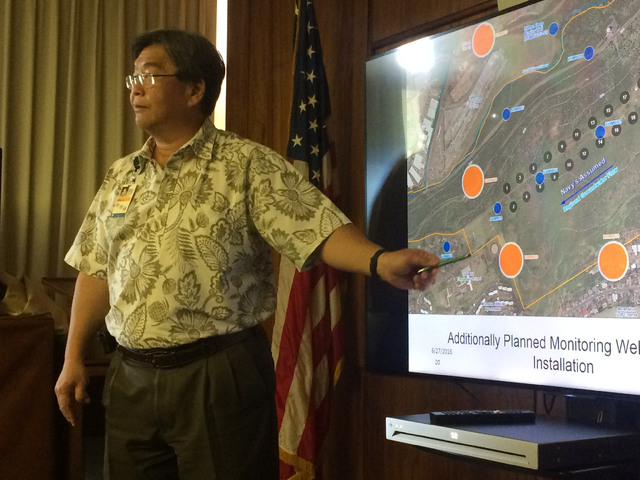HONOLULU (AP) — The U.S. Environmental Protection Agency told Honolulu water utility officials on Monday it has approved three out of four new wells the Navy plans to build to help monitor the threat of leaks from giant fuel storage
HONOLULU (AP) — The U.S. Environmental Protection Agency told Honolulu water utility officials on Monday it has approved three out of four new wells the Navy plans to build to help monitor the threat of leaks from giant fuel storage tanks near Pearl Harbor.
The EPA’s Red Hill project coordinator, Bob Palarino, told the Honolulu Board of Water Supply via video conference from San Francisco that the location of the fourth well still needs to be finalized.
The Navy already has 10 monitoring wells around the 70-year-old underground tanks. The tanks, which are 250 feet tall and 100 feet in diameter, sit atop an aquifer that supplies about a quarter of the water consumed in urban Honolulu. This has the utility concerned that fuel from previous or future leaks may contaminate the city’s water supply.
The EPA, the state Department of Health, the Navy and the Defense Logistics Agency signed an agreement to address the threat of leaks after the Navy detected the seepage of 27,000 gallons of fuel from one tank in 2014.
Their agreement calls for studying options for upgrading the tanks and then fixing them over the next 20 years. Tanks not upgraded will be taken out of service.
Pulama Long, an intern with the Sierra Club, testified at the board meeting that she was disappointed with the pace of the work.
“I feel there’s a definite lack of urgency to further stop contamination as well as a lack of urgency for solutions to clean up in a very timely manner,” Long said.
The tanks are the largest of their kind in the world. They provide fuel to U.S. military ships and aircraft, serving as a strategically important “gas stop” between the U.S. West Coast and the western Pacific.
The tank identified as the source of the leak detected in 2014 had undergone maintenance shortly before it was found to have accidentally released fuel.
Steve Linder, the underground tanks program manager for the EPA’s region 9, which includes Hawaii, told the board the contractor who performed the maintenance had never done similar work on other Red Hill tanks.
This contractor used different procedures than other contractors, in large part because of the way it interpreted quality assurance requirements, he said.
“What we’re already seeing is a lot of opportunity for improvements on the way contracts are written in the way to do this work,” Linder said.



